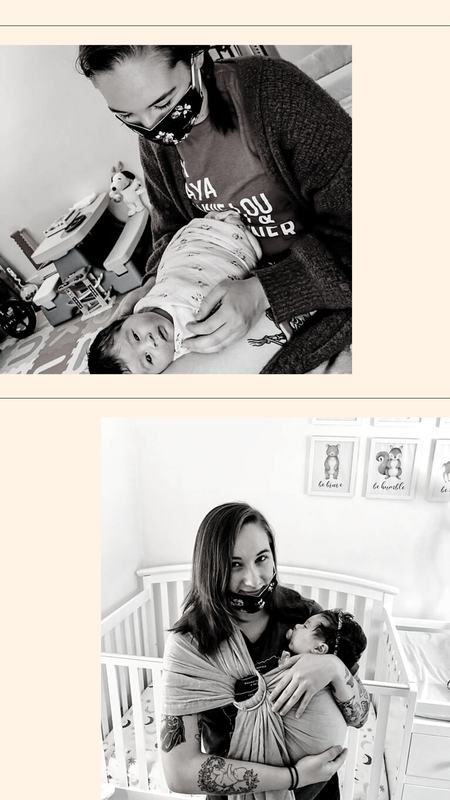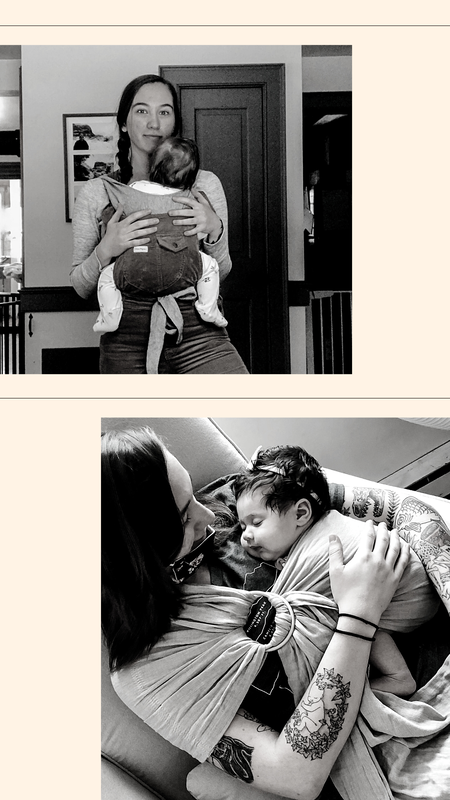|
Basics of Babywearing Babywearing is a practice that has been around for years and years. Babywearing took a mainstream turn in the 1960s when the Snugli baby carrier was invented. Peace Corp volunteers in Togo, West Africa were inspired by the way mothers wore their babies. Ever since then it seems there are a million different options when it comes to which types of carriers to purchase. Babywearing Positioning If you choose to babywear, it is important to practice babywearing safety with carrying. One key safety tip: babies should always be positioned in a way that they are not breathing in the same air, with baby's head and baby's face turned to the side. Be cautious of how baby's legs are positioned also. Baby’s thighs should spread around your torso with their knees bent slightly higher than their bottom. Always check to see if your carrier is approved by the international hip dysplasia institute. Baby should not face outward until they’re 6 months old with strong head and neck control, and structured carriers should only be used for infants over 7 pounds. Benefits of Babywearing Babywearing is a great way to multitask. A baby wearer gets to be hands free, which is one of the many benefits of babywearing. So whether you’re cooking dinner, running errands, or double wearing multiples, babywearing is extremely helpful! A few of the other benefits of babywearing include:
Slings The sling is a one shoulder carry great for small babies into toddlerhood. I personally love the ring sling. It is very quick and convenient once you get the hang of it. A few favorite ring slings are designed by Aloha and Light and WildBird. With newborns, a snug front carry is preferred and with babies over five months, more of a hip carry works better. Toddlers may enjoy the back carry more and you will probably find it much more comfortable for that age! Ring slings are super compact and probably the easiest carrier to toss in the diaper bag. Wraps: Woven vs Stretchy I love a stretchy wrap (like the Moby wrap, Boba or Baby K'tan), but in my experience as a babywearing educator, people with heavier babies tend to like the structure of the woven wraps more. The stretchy wrap is extremely comfortable and feels like a second layer of clothes when worn. There are tons of ways to wrap and it can seem intimidating at first, but the learning curve isn't high. Once you find your favorite wrap style it’s easy to just stick with that and really enjoy the wrap life! Wraps are similar to a long piece of fabric, and tend to be quite long, usually about 18 feet. I recommend wrapping before getting in the car to go somewhere. That way it is ready for the baby upon arrival at our destination! Mei Tai These carriers are soft material with a structured back panel. Straps are pulled around the waist and other the shoulder, then tied into a secure knot. They are versatile and can be tied in more ways than a sling, but not as many as a wrap. They can be used with all ages, are convenient, not super bulky, and quite comfortable. Soft Structured Carriers This type of carrier, also known as an SSC, has a structured seat, padded shoulder straps, and buckles on the back and waist. They are quick to put on, but may require an extra set of hands to help buckle or adjust. My personal favorite is the Lillebaby because of the amazing back support (but Ergobaby, Baby Bjorn and Beco also make great soft structured carriers). These carriers also typically come with attachments like infant inserts and sunguards! Onbu The onbuhimo is meant for infants sitting independently up to toddlerhood. It is extremely easy to put on and doesn’t involve any kind of waistband. It is a Japanese style carrier with a chest belt. The style is similar to a backpack, but can be used to front carry. Back carries tend to be more comfortable all around. If you do choose to babywear, be sure to take your carrier with you on the go - just as you would your car seat and stroller. You never know when babywearing will come in handy! Happy Babywearing!
0 Comments
Leave a Reply.The light isn't green forever. AuthorJess Kimball is a Full Spectrum Doula and Certified Lactation Counselor trained in Ayurvedic and Chinese medicine. |
|
EST. 2016
North Carolina | Vermont Jess Kimball |
© COPYRIGHT 2015. ALL RIGHTS RESERVED.
Jess Kimball provides doula care, birth photography, and a variety of other services to families!
|

 RSS Feed
RSS Feed
